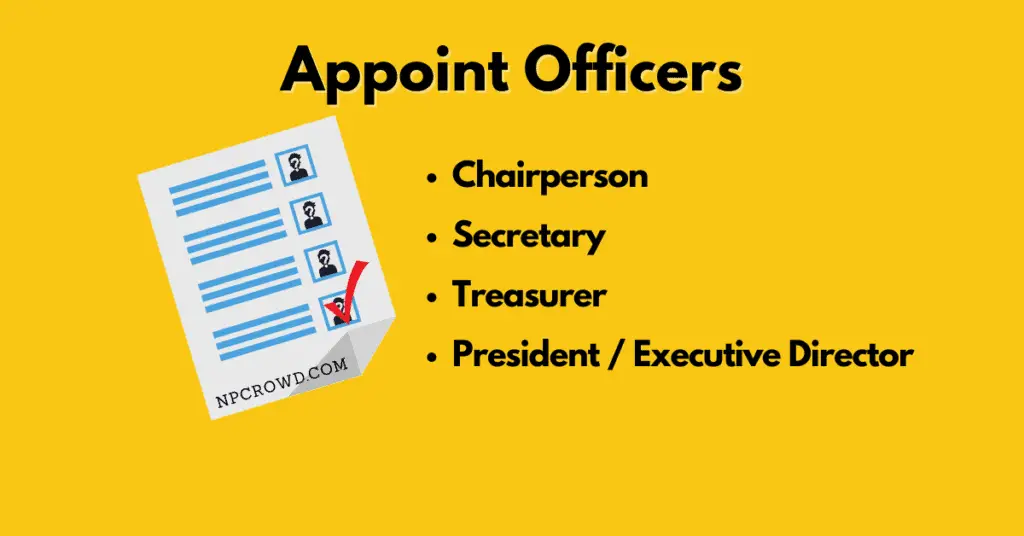Nonprofit’s First Board Meeting Success: 9 Must Do’s & Examples
Disclaimer: This post may contain affiliate links. These links, if used and purchases made, we may earn a small commission. These affiliate programs do not impact the recommendations we make or the resources we refer you to. Our focus is on providing you the best resources for your nonprofit journey.
Congratulations. You’ve selected your nonprofit board members and they have agreed to serve. You’ve scheduled the first board meeting but wait, what has to happen at this first board meeting?Ensuring the right things happen at the inaugural board meeting will help streamline the process. Let’s look at what things the first board meeting should include.
How To Hold Your First Nonprofit Board Meeting
In general, the first board meeting of a new nonprofit should include 9 specific items: attendance and quorum, temporary officers, record Articles of Incorporation, adopt Bylaws, record the initial board and terms, appoint board officers, designate principal offices, authorize corporate bank accounts, and authorize tax exemption application.
Let’s review each one.
1. Roll Call
This is the very first step after calling the meeting to order and noting the date, time and place the meeting began.
In this step, identify who is present and absent and note this in your minutes. Ensure you have a quorum and not that in the minute that you do.
Now it’s time to proceed with the rest of the meeting.
2. Elect Temporary Officers
Next, it is time to elect a temporary Board Chair and Secretary to complete the rest of the meeting. These are required roles as the chair will run the meeting and the secretary will record the minutes.
In order to elect each temporary position, a motion, second, discussion, and vote is required.
RESOLVED: Upon motion duly moved, seconded and carried it was resolved that __________________ would serve as temporary Chairman of the meeting.
RESOLVED: Upon motion duly moved, seconded and carried it was resolved that __________________ would serve as temporary Secretary of the meeting.
3. Record Articles Of Incorporation
Next, the finalized, state approved Articles of Incorporation need to be recorded into the meeting minutes.
This is done by the Chairperson making a motion, second, discussion and vote along the following lines:
RESOLVED: Upon motion duly moved, seconded and carried it was resolved that the Secretary is to make and place a copy of the certified articles of incorporation and store them in the corporate records to be retained at our principal office.
Then the Secretary will, after the meeting, make a copy of the Articles of Incorporation and place them in the corporate records binder or safe.
4. Adopt Bylaws
Adopting the Bylaws is an important action in the life of the nonprofit Board. While we recommend emailing a copy of the Bylaws to each board member before the first Board meeting, it is not required.
Doing so can speed up the process since everyone will have already had an opportunity to review the Bylaws prior to the meeting.
Again, the Chairperson should make a motion to adopt the presented Bylaws as the Bylaws of the organization.
RESOLVED: Upon motion duly moved, seconded and carried it was resolved that the presented Bylaws be adopted as the Bylaws of the organization.
5. Record Board Members And Terms
Technically this step is not required but we believe it is a best practice to maintain an ongoing documentation of Board members, their appointment date and the length of term they are serving.
There is no formal motion that needs to be made but I would suggest the Chairperson review the document with the board and ensure the information is accurate.
Then, simply keep this document up to date in included in each Board meeting packet.

6. Appoint Officers
Appointing officers is arguably one of the most important steps. This is where the Board designates the President (Executive Director), and elected other key officers.
The positions that should each be motioned and voted on include:
- President (Executive Director)
- Chairperson of the Board
- Secretary
- Treasurer
It is certainly possible for one person to be in more than one officer role however, the President should not also be the Secretary and the Chairperson should not also be the Secretary.
RESOLVED: Upon motion duly moved, seconded and carried it was resolved that __________________ would serve as Chairperson of the Board.
RESOLVED: Upon motion duly moved, seconded and carried it was resolved that __________________ would serve as Board Secretary.
RESOLVED: Upon motion duly moved, seconded and carried it was resolved that __________________ would serve as Board Treasurer.
RESOLVED: Upon motion duly moved, seconded and carried it was resolved that __________________ would serve as President/Executive Director.
NOTE: In a subsequent Board Meeting, it is recommended that the Board, in Executive Session, discuss and set the Executive Director/President’s compensation. Remember, the President/ED does not get to pick their own salary as they report to the Board of Directors.
7. Designate Principle Offices
This is just a formality of having the Board of Directors confirm the location of the principal offices of the corporation.
RESOLVED: Upon motion duly moved, seconded and carried it was resolved that the principal offices of the corporation are located at ______________________________________________.
8. Authorize Bank Accounts
Now is the time to designate who can open the bank accounts and where those bank accounts should be opened.
With some homework before the first Board meeting, you will have already identifies the name and location of the financial institution you plan to use.
RESOLVED: Upon motion duly moved, seconded and carried it was resolved that ______________________________ is authorized to open a corporate business checking account and a savings account for the corporation at the __________________________ bank.
There will also need to be a vote to authorize who will be signatories on the bank accounts. Typically I see the Executive Director and Treasurer as the two signatories receiving authorization.
RESOLVED: Upon motion duly moved, seconded and carried it was resolved that ______________________________ and _______________________________ are authorized as signatories on all corporate bank accounts.
9. Authorize Application For Tax Exemption
Finally, the Board of Directors should authorize the application for tax exemption with the IRS. This is authorizing the Executive Director, or other officer, to apply for the 501(c)(3) exemption.
RESOLVED: Upon motion duly moved, seconded and carried it was resolved that ______________________________ is authorized to apply with the Internal Revenue Service for tax-exempt status as a 501(c)(3) charitiable organization.
Wrap Up
Your first nonprofit Board of Directors meeting is an exciting milestone. But, if you forget to have the Board approve certain things, your ability to finish your nonprofit status journey can be delayed. By following our list of 9 important items to include in your first nonprofit Board meeting, you’ll be able to move along quickly without making these same mistakes.







